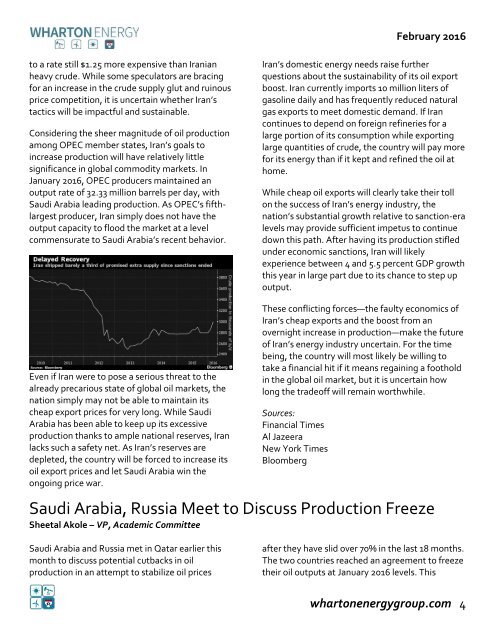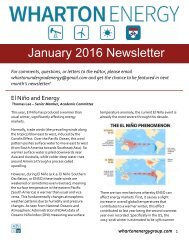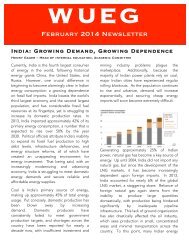You also want an ePaper? Increase the reach of your titles
YUMPU automatically turns print PDFs into web optimized ePapers that Google loves.
<strong>February</strong> <strong>2016</strong><br />
to a rate still $1.25 more expensive than Iranian<br />
heavy crude. While some speculators are bracing<br />
for an increase in the crude supply glut and ruinous<br />
price competition, it is uncertain whether Iran’s<br />
tactics will be impactful and sustainable.<br />
Considering the sheer magnitude of oil production<br />
among OPEC member states, Iran’s goals to<br />
increase production will have relatively little<br />
significance in global commodity markets. In<br />
January <strong>2016</strong>, OPEC producers maintained an<br />
output rate of 32.33 million barrels per day, with<br />
Saudi Arabia leading production. As OPEC’s fifthlargest<br />
producer, Iran simply does not have the<br />
output capacity to flood the market at a level<br />
commensurate to Saudi Arabia’s recent behavior.<br />
Iran’s domestic energy needs raise further<br />
questions about the sustainability of its oil export<br />
boost. Iran currently imports 10 million liters of<br />
gasoline daily and has frequently reduced natural<br />
gas exports to meet domestic demand. If Iran<br />
continues to depend on foreign refineries for a<br />
large portion of its consumption while exporting<br />
large quantities of crude, the country will pay more<br />
for its energy than if it kept and refined the oil at<br />
home.<br />
While cheap oil exports will clearly take their toll<br />
on the success of Iran’s energy industry, the<br />
nation’s substantial growth relative to sanction-era<br />
levels may provide sufficient impetus to continue<br />
down this path. After having its production stifled<br />
under economic sanctions, Iran will likely<br />
experience between 4 and 5.5 percent GDP growth<br />
this year in large part due to its chance to step up<br />
output.<br />
Even if Iran were to pose a serious threat to the<br />
already precarious state of global oil markets, the<br />
nation simply may not be able to maintain its<br />
cheap export prices for very long. While Saudi<br />
Arabia has been able to keep up its excessive<br />
production thanks to ample national reserves, Iran<br />
lacks such a safety net. As Iran’s reserves are<br />
depleted, the country will be forced to increase its<br />
oil export prices and let Saudi Arabia win the<br />
ongoing price war.<br />
These conflicting forces—the faulty economics of<br />
Iran’s cheap exports and the boost from an<br />
overnight increase in production—make the future<br />
of Iran’s energy industry uncertain. For the time<br />
being, the country will most likely be willing to<br />
take a financial hit if it means regaining a foothold<br />
in the global oil market, but it is uncertain how<br />
long the tradeoff will remain worthwhile.<br />
Sources:<br />
Financial Times<br />
Al Jazeera<br />
New York Times<br />
Bloomberg<br />
Saudi Arabia, Russia Meet to Discuss Production Freeze<br />
Sheetal Akole – VP, Academic Committee<br />
Saudi Arabia and Russia met in Qatar earlier this<br />
month to discuss potential cutbacks in oil<br />
production in an attempt to stabilize oil prices<br />
after they have slid over 70% in the last 18 months.<br />
The two countries reached an agreement to freeze<br />
their oil outputs at January <strong>2016</strong> levels. This<br />
whartonenergygroup.com 4









